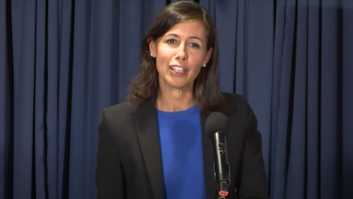IBOC Will Have To Play Catch-Up With Satellite Radio, But Will Other Similarly Named Competition Interfere?
Each year, the Consumer Electronics Show gives insight to the latest technologies’ deployment pace and provides a good gauge of their relative impact to date. After last year’s show, it seemed obvious that IBOC needed to make a good showing soon if it had hope of catching the public’s attention – particularly in the growing shadow of satellite radio’s high profile.
At CES 2006, both of the satellite radio services seemed to be at approximate parity with even stronger showings, evidenced by a wide range of fixed, mobile and portable receivers – including a new crop that integrates satellite radio with MP3 players (see the Oct. 26, 2005, column in The Big Picture online archives at www.rwonline.com ). Sirius and XM have become established brands, and are now standard terms of art at CES.
Meanwhile, HD Radio was more in evidence at CES 2006 than ever, but it was still far from achieving the status of satellite radio. This is to be expected given HD Radio’s later arrival on the scene, but the lag that exists today may be difficult to overcome.
It’s generally understood that XM’s continuing lead in subscriptions over rival Sirius is due primarily to the one-year advantage in time-to-market that XM achieved. Sirius was behind from the start, and although both services continue to experience robust growth, Sirius has found it hard to gain ground on XM’s lead. This lesson may be applied to HD Radio’s even later entrance.
Of course, HD Radio is not a direct competitor like the two satellite services are, so the comparison is not a completely apt one; but from the consumer electronics side, they all fall into a similar basket of new digital radio products. Many of the CE vendors showing satellite radios this year promised HD Radio receivers next year, but in the meantime satellite radio will add another year to its already long head start in their product lines. Trying to play catch-up from that far back will be challenging for HD Radio, and its marketing support will have to be extremely intense and effective if it is to help reduce the gap, and ultimately provide HD Radio the same “household name” status that both satellite radio services already enjoy.
Addition vs. replacement
Even more troubling for terrestrial broadcasters is the trend seen essentially for the first time at CES 2006, in which satellite radio products without terrestrial radio receivers made their debut. Previous Sirius or XM receivers at the show nearly always included AM/FM capabilities, and although most car receivers shown this year continued this trend, handhelds and other satellite radio products have dropped either AM or AM/FM tuners.
Could satellite radio truly replace terrestrial broadcasting for its subscribers, and become the only radio service they use?
For some, the question may rest on local content. Just what and how much local content is enough? Satellite radio subscribers in major markets who only care about local traffic and weather could already be satisfied by XM’s or Sirius’s services in this respect, and may not miss the AM/FM bands if they were omitted from a receiver. In this way, satellite radio may do to FM what FM did to AM, causing younger audiences to almost completely ignore the older band, and not protest if it were eliminated from some – or eventually all – receivers.
This could dramatically alter the balance of the industry and deployment plans for HD Radio. There has been some expectation that future satellite radios might include HD Radio capabilities, and that such “bundling” could be an important method of passive adoption by consumers who were really after satellite radio, but also got HD Radio in the bargain. Yet because HD Radio’s multicast and possible surround-sound features could provide stronger competition to satellite radio, and given satellite radio services’ common practice of subsidizing receiver production, it seems likely that manufacturers may be persuaded against including HD Radio – if they even include terrestrial radio capability at all – in future satellite radio designs.
Thus the terrestrial radio industry would be on its own in promoting consumer adoption of HD Radio, and it could be posed as an either/or proposition against satellite radio for consumers.
The field grows larger
This dreary scenario becomes further muddled when one considers yet another trend seen at CES 2006.
It involves the new competitive services about to launch from terrestrial wireless providers, which may make HD Radio’s quest toward critical mass even harder to achieve. These include Qualcomm’s MediaFlo, Crown Castle’s Modeo, Motorola’s iRadio, Sprint’s MSpot Radio and Verizon’s VCAST, with probably more to come. Note that these services either use the “R” word, or sound a lot like it, making their intentions to compete head-to-head with terrestrial radio broadcasting explicitly clear.
Marketing and deployment campaigns for these services will be difficult for terrestrial radio to compete with, given the deep pockets of the wireless telco operators behind them, and the high likelihood of subsidies for consumer equipment. The fact that such devices will be converged products that also provide highly desirable and well-established communications services (voice, wireless e-mail, web surfing, etc.) makes them even more appealing.
So HD Radio is now in a race for the consumer’s attention against two other opponents who’ve been spotted a long lead, with a lot more late entrants now loading into the starting gate. Trifecta, anyone?











